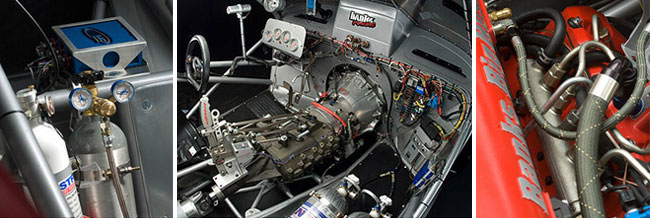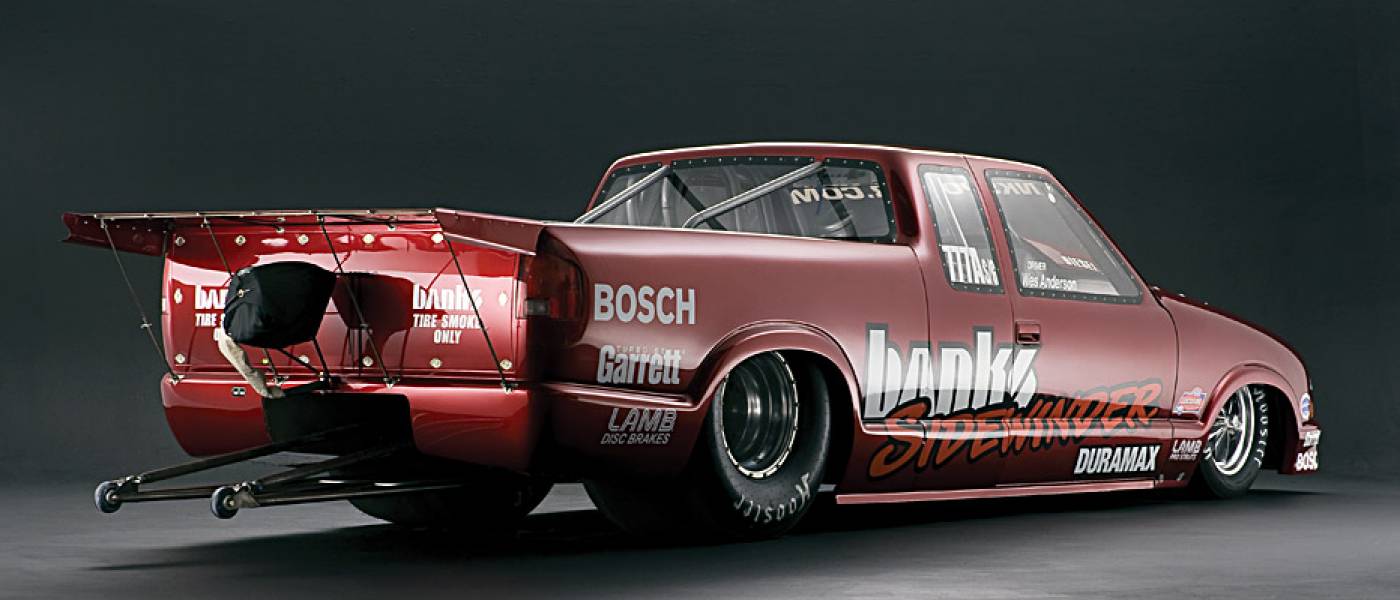Clean Speed
Diesel Power February 2008
Diesel Power Magazine takes a look inside the world’s quickest and fastest diesel pickup.
A few years ago, Gale Banks got a deal he couldn’t refuse on a Don Ness-built Pro Stock Chevy S-10. The truck had a full tube chassis and a unique swingarm rear suspension with excellent torque handling capabilities. It had even been painted red. The goal was to build a diesel drag truck that could run smoke-free during the burnout and staging, and down the quarter mile. Not only that, the truck would have to compete against some tough competition, as many trucks were already well into the 8-and 9-second range.
Fast-forward a year or two. It’s now October of 2007, and the new Banks Sidewinder Type-D drag truck is ready to run. After a few 9-second shakedown passes, the truck quickly progressed to a 8.21-second at 165 mph run in the quarter mile – a new record for diesel-powered drag trucks. Not only had the truck been competitive, but it beat the old record! And it did so with no black smoke the entire time.
The truck itself is a 2001 S-10 that was run in the NHRA Pro Stock Truck class back before the class was retired. Per NHRA rules, the truck body had to remain somewhat stock, so the cab and bed are actually steel. The doors, however, are fiberglass, as is the lift-off front end, and the bed cover is aluminum. Just because the truck has steel in it doesn’t mean it is heavy. Weight was shaved everywhere else, as trick parts like Lamb struts with titanium springs are used up front, while carbon fiber wheel tubs help the rear shed some pounds. Lightweight American Racing wheels and Hoosier front runners keep down rolling resistance in the front, while big 33.5×16.5×15 Hoosier slicks and Weld Racing wheels provide traction in the rear. A 64-channel EFI data logger keeps track of everything from turbo speeds to shock travel to aid in tuning the Type-D. The end result is a well-balanced and well-designed platform that weighs a mere 2,600 pounds without a driver

With the chassis taken care of, the next order of business is the drivetrain. Here, a liberty 5-speed manual transmission is used, while a trick Bruno torque converter drive with a Coan converter takes the place of a conventional clutch setup. This is done to help spool the turbos at the line so the truck can leave under full boost. As high-tech as it is, it isn’t the chassis or the drive system that is the real story here, because the Type-D is powered to low, 8-second passes by a Duramax diesel engine.
When the project was started, Banks knew that he wanted the truck to be fast, but he also had other plans. The drag truck was to be a test bed for a high-speed diesel project and an engine that could turn up to 5,000 rpm, reliably. It also would be used to develop many new racing parts for the new “Banks Speed” lineup, in addition to acting as a stand-alone engine management system for 4-, 6-, and 8-cylinder engines. In developing the engine for the Type-D, the Banks team started off with an ’06 LBZ block and crank. Then they added Crower rods to the mix, along with ceramic coated LLY pistons that are fly cut for a big cam. The heads use larger valves and are custom ported. The valvetrain is mostly stock, save for a set of beehive springs and a set of lifters that are reworked from a NASCAR-style application to save weight. The engine also uses a custom billet flywheel, a billet camshaft, and a big-block Chevy front crank hub and damper. Oiling is handled by a custom 5-stage dry sump system.
Up top, an individual runner intake is used to promote even airflow among the cylinders, while a set of Garrett TR30R turbos mounted in parallel (not compound) are used. A custom set of headers were TIG-welded for this application, and use Banks wastegates. For fueling, a single stock CP3 injection pump is used, while a Magnafuel lift pump and boost-referenced Aeromotive regulator provide plenty of fuel to the hungry CP3. The fueling is handled by Bosch, and a set of custom Bosch injectors and prototype ECU are used to keep the engine happy. So what does all this technology add up to? A dyno-tested 775 flywheel horsepower with no smoke on diesel fuel only.
Banks wasn’t quite done, however, and found that it could add more power with nitrous even though the engine was producing no visible smoke. A few runs later, the dyno got a rest after the engine made a whopping 1,045 horsepower with the progressive NX nitrous system activated. The nitrous system is used to help staging, and when the pedal is floored, the computer has to ramp up the fuel and nitrous at the same time that the cam and turbos come in, resulting in some very delicate turning. Too much nitrous and the engine will sputter and stall; too little and the vehicle could smoke when trying to “quick stage.” So far, the team has gotten the vehicle to go from a fast idle to full RPM launch in under two seconds, which is incredibly quick for a diesel. Since the truck has no intercooler, nitrous is used down the track for added horsepower and cooling
After the launch, the truck has covered the first 60 feet of track in just 1.17 seconds, which is also a record for a diesel truck. Boost is maintained at about 38psi the whole way down, while the nitrous keeps the EGTs down to 1,500 degrees F through the traps. The truck leaves at over 4,000 rpm and shifts at 4,850 rpm. A 2.91 gear is used in the fabricated rear-end in order to keep the engine in its power band. In addition to the record 8.21-second run, the truck has made many passes in the 8.40s, indicating that it is not only fast, but consistent
When we talked to Gale about his truck, he was honest about the fact that new technology was a big help in making a smokeless truck. Everything from the small twin turbos to the high-swirl cylinder heads were engineered not to smoke. The entire engine had to not only make power, but it had to be as efficient as possible in order to run smoke free. This mantra led to hundreds of hours of testing on the dyno to get the cam, turbos, heads, and fueling to work together. Greater power and efficiency through technology is what the team was shooting for, and it looks like they succeeded. They picked the right truck as a platform, put a drivetrain in that could handle the power, and spent countless hours tuning the engine (the instruction manual for the Bosch ECU is 1,200 pages) in order to get the tuning right. In the end, their goal of smoke-free power was a slam-dunk of a success, and they just happened to build the world’s quickest diesel pickup in the process.
Visit Diesel Power magazine online!

